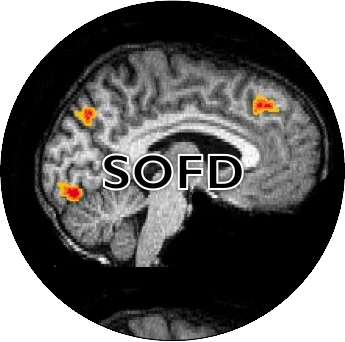
Tweet
November 4, 2015
Proceedings of the Natural Institute of Science | Volume 2 | HARD 12
Beards of War: Relationships between facial hair coverage and battle outcome in the U.S. Civil War
Matt J. Michel1
1 - PNIS

Introduction
Science has affirmed the numerous benefits of facial hair. It acts as a natural sunscreen against UV rays. It enhances one’s social status. It makes males appear more masculine and healthier. It’s thought to reduce the risk of infection, delay the onset of wrinkles, and filter allergens such as pollen and dust. It even makes sponsors more credible when endorsing products.
It would be natural to assume, then, that beards would improve all sorts of abilities of their bearers. But could the presence of facial hair on a military commander lead to greater success on the battlefield? Well, which of the following would you expect to be victorious in combat: 1) a healthy, masculine commander whose face is free of greasy sunscreen and brain unclouded by Benadryl, or 2) a sniffling, visibly wrinkled and acne-scarred officer whose sunblock sweat keeps dripping into their watery, itchy eyes?
The clear answer should be the former, yet no study has ever examined how facial hair affects military performance. Using the facial hair data gathered on commanders of the U. S. Civil War (USCW) in our previous paper, and this dataset on major battles of the USCW, we evaluate the hypothesis that bearditude positively correlates with military success.
Datasets
Facial Hair Dataset – Our dataset on the facial hair of USCW commanders was described in that previous paper. In brief, we use a Beard:Face ratio which describes the area of a person’s beard divided by the area of a person’s face (excluding beard). Also note that we use the terms ‘facial hair’ and ‘beard’ interchangeably.
Beard types were split into 11 different styles and representations of each style can be found in this graph.
Battles Dataset – The National Park Service has a dataset of the 383 major battles of the USCW, in which they list the battle name, name of Union and confederate commanders, outcome, and number of casualties for each side (casualties include number of deaths, wounded, and captured). All battles have an outcome (e.g., Union Victory, Confederate Victory, or Inconclusive), but only 196 of the battles have information on casualties.
We only obtained Beard:Face ratio data for commanders that were involved in the 196 battles that had complete casualties data. However, some of these commanders were in battles that did not have casualties data; hence the differences in sample size when talking about victories and talking about casualties.
These two datasets were used for all the following analyses in an attempt to answer our overall question: Does facial hair of a commander lead to greater success on the battlefield?
First, some summary statistics
Altogether, Long Bearded commanders were involved in the most battles: 54 for the Union side and 108 for the Confederates. They were followed closely by Short Beards (101 Union, 57 Confederate). Then, in descending order, are Van Dykes (U: 39, C: 46), Moustaches (U: 32, C: 20), French Cuts (U: 20, C: 31), Clean Shavens (U: 12, C: 25), Friendly Muttonchops (U: 21, C: 3), Muttonchops (U: 6, C: 11), Chin Curtains (U: 11, C: 3), Muttonchops with Moustaches (U: 4, C: 5), and Goatees (U: 0, C: 7).
Question 1: Does the commander with the larger Beard:Face ratio win more battles?
A straightforward question: When two commanders face off in battle (like George Meade against Robert E. Lee in the Battle of Gettysburg) does the commander with the greater Beard:Face ratio come out victorious?
There were 226 battles in which we had Beard:Face ratios of the opposing commanders. Of those, the commander with the bigger beard won 114, or 50.4%, of them. So, basically the more barbate commander won only two more battles than less barbate. Strike one for beard power.
Question 2: How well did each Facial Hair Type fare in battle?
Similar to the Standings of any professional sports league, we can construct the Standings (Wins, Losses, Ties) for each type of facial hair.
Table 1 gives the overall standings (Union and Confederate combined) for each facial hair type.
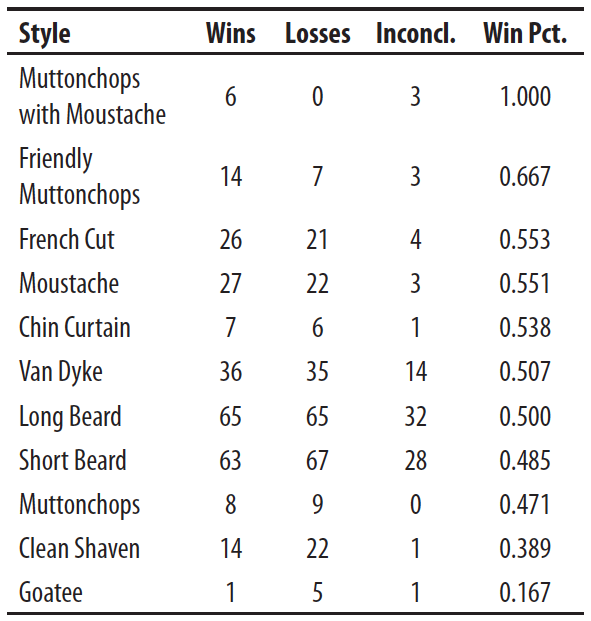
Raise your hand if you thought that the only undefeated facial hair style would be Muttonchops With Moustache. Most of their success came from Union Maj. Gen. John Parke and Confederate Maj. Gen. John Magruder, who both gained two victories each. Friendly Muttonchops surprisingly comes in second place. Say what you will about Ambrose Burnside, the poster child for Friendly Muttonchops, but he did have 5 victories to 2 losses (both to Robert E. Lee).
Most other styles hovered around the 50% mark. However, it is notable that Clean Shaven commanders had 14 wins and 22 losses, winning a paltry 39% of their battles. So, perhaps not having facial hair does negatively affect military performance. Ball one for beards, maybe?
Question 3: How did each Facial Hair Type fare against the other Facial Hair Types?
Figure 1 gives the answer to this question. To help you read this graph: the columns are the facial hair types for the Union and the rows are the facial hair types for the Confederates (note that there are no Goatees for the Union). The color of the square corresponds to the winning percentage of the Union commander (so, blue means the Union won more battles, gray means the Confederate won more battles, and pink means they split 50:50). For example, a Union Long Beard (first column) won 100% of the battles against a Confederate Goatee (third row), but lost 100% of the battles against a Confederate Muttonchops With Moustache (seventh row).

Here, we have mixed success for beards. For example, a Union Long Beard won the majority of battles against a Confederate Clean Shaven, but a Confederate Long Beard was never able to defeat a Union Clean Shaven. Then again, Confederate Clean Shavens were never able to beat 5 different Union Facial Hair Types. So, maybe this a foul ball for the Beards.
Question 4: Which Facial Hair Type suffered the most Net Casualties?
Instead of looking at Battle Victories and Losses (a qualitative measure), we can look at a more quantitative measure of performance—the amount of casualties inflicted and incurred by commanders of each type of facial hair.
We wanted a better measure of Net Casualties than just subtracting # Incurred (i.e. suffered) from # Inflicted (because some commanders, like Robert E. Lee, were involved in many battles having high #’s of casualties). So, for each battle, we divided the total number of casualties incurred by the total number of casualties in that battle. We then multiplied by 100 to get a percentage (so, this would equal % own casualties). Then we took 50 minus this percentage to get positive and negative numbers. Thus, a negative percentage means that the commander lost more troops than inflicted, while positive means the opposite.
Figure 2 shows % Net Casualties grouped by Facial Hair Type and by Union and Confederate. Here, we can see a little more clearly how bad Confederate Clean Shavens were, having the greatest negative % Net Casualties for the Confederates. Chin Curtains claim that title for the Northerners. We can also see that, despite winning about 2/3rd’s of their battles, the Friendly Muttonchops lost a bunch of their own soldiers. That might explain some of the hate directed at Ambrose Burnside.
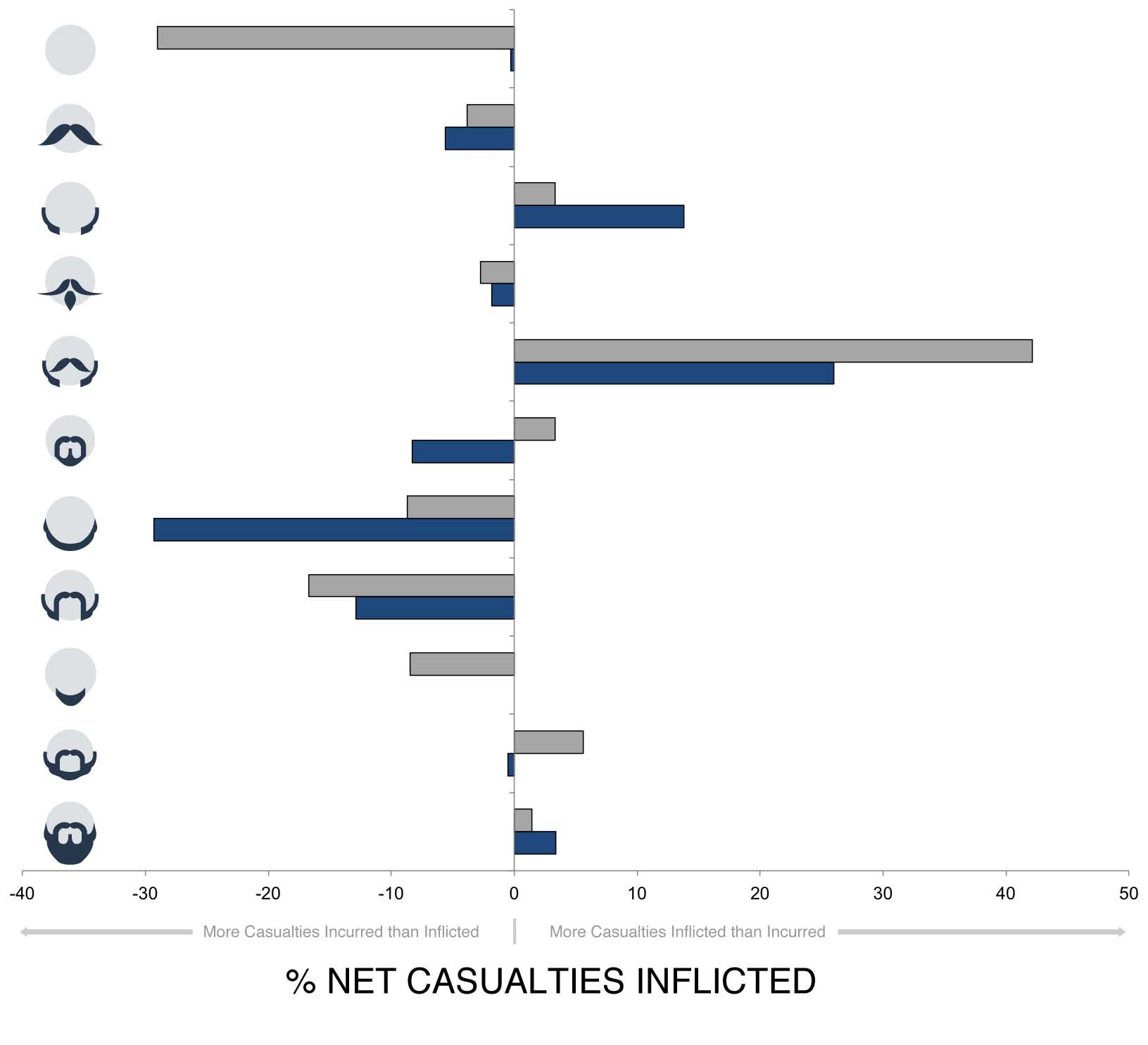
On the positive side (i.e., inflicted more casualties than suffered), we again see the clear dominance of the Muttonchops With Moustaches as well as the plain Muttonchops for both sides. As for the fully bearded types, Long Beards lost less of their own men, as did Confederate Short Beards, but not Union Short Beards. Again, we seem to have mixed support for beard power.
Question 5: Is there a relationship between Beard:Face ratio and % Net Casulaties?
Maybe if we use a more quantitative measure of beardiness, instead of just sorting them into types, we can get a stronger relationship between beards and military success.
Figure 3 shows the relationship between % Net Casualties (y-axis) and Beard:Face Ratio (x-axis) for each commander in our dataset, separated by Union (blue) and Confederate (gray). Negative % Net Casualties indicates that the commander lost more of their own men. [Note: if you click on the graph, you will see a graph that shows the names of all the commanders next to their respective data point.]
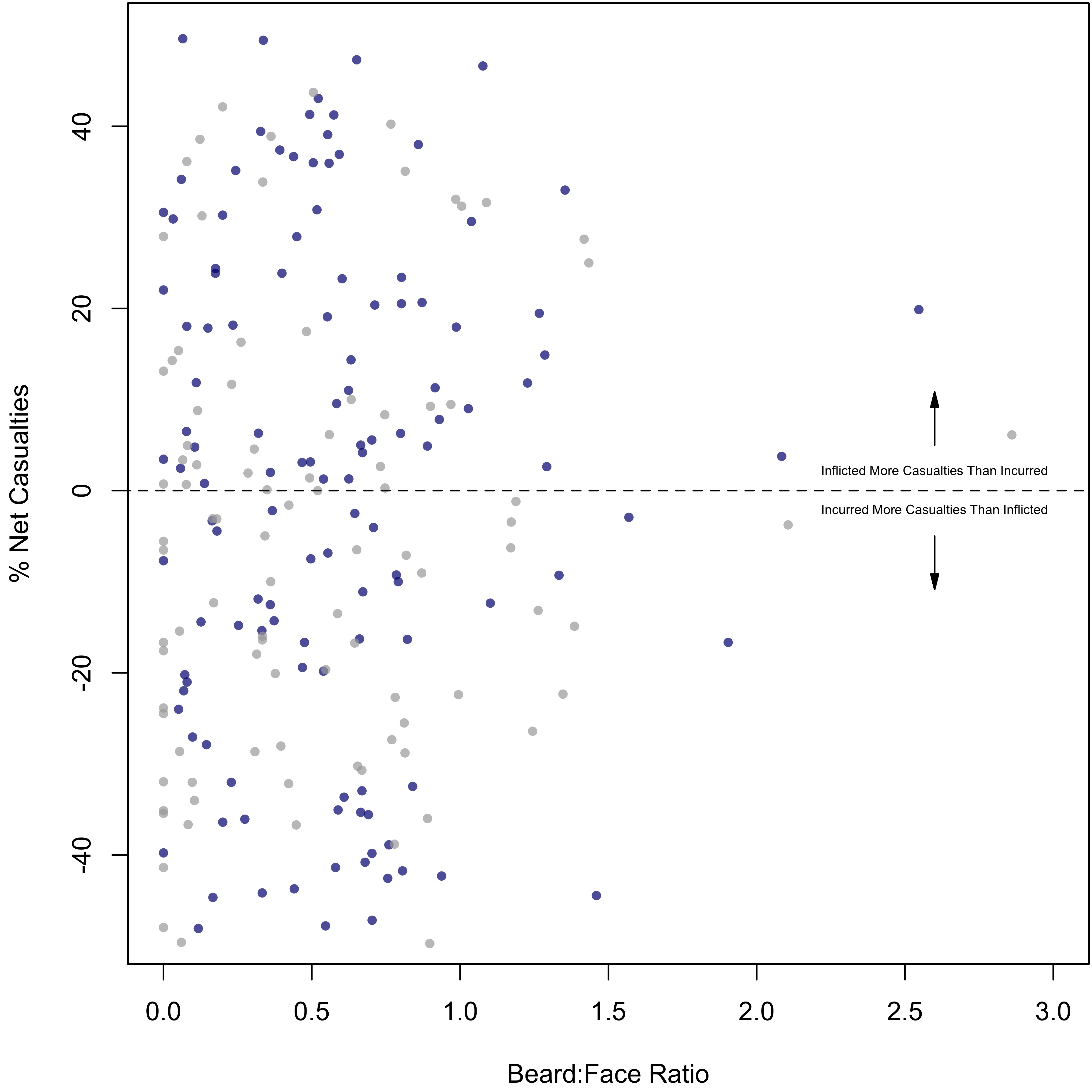
If commanders with bigger beards inflicted more casualties, the dots would form sort of a diagonal line from the bottom left to the top right. But, as you can see, there is no such line meaning that there is no positive or negative relationship between Net Casualties and Beard:Face Ratio, either grouped by North and South or considered altogether. We would give you the P-values but they’re so bad, it would make you spit out whatever beverage you are currently enjoying. This is a big strike against beards: having a larger beard in no way leads to the infliction of more casualties in war.
Question 6: Did the commander with the larger Beard:Face ratio inflict more casualties in each battle?
Ok, so maybe there’s no relationship between Beard:Face Ratio and % Net Casualties among the commanders. But what if we look at every battle and see if the commander with the greater beard inflicted more casualties?
Figure 4 shows the relationship between % Net Casualties by Union Commander (so a value above 50% means that the Confederates suffered more casualties) and the Difference in Beard:Face ratios among the commanders (where a value greater than 0 means that the Union commander had a bigger beard). The colors indicate the outcome of the battle. As in Figure 3, if you click the graph, you will see the names of each battle next to its respective point.
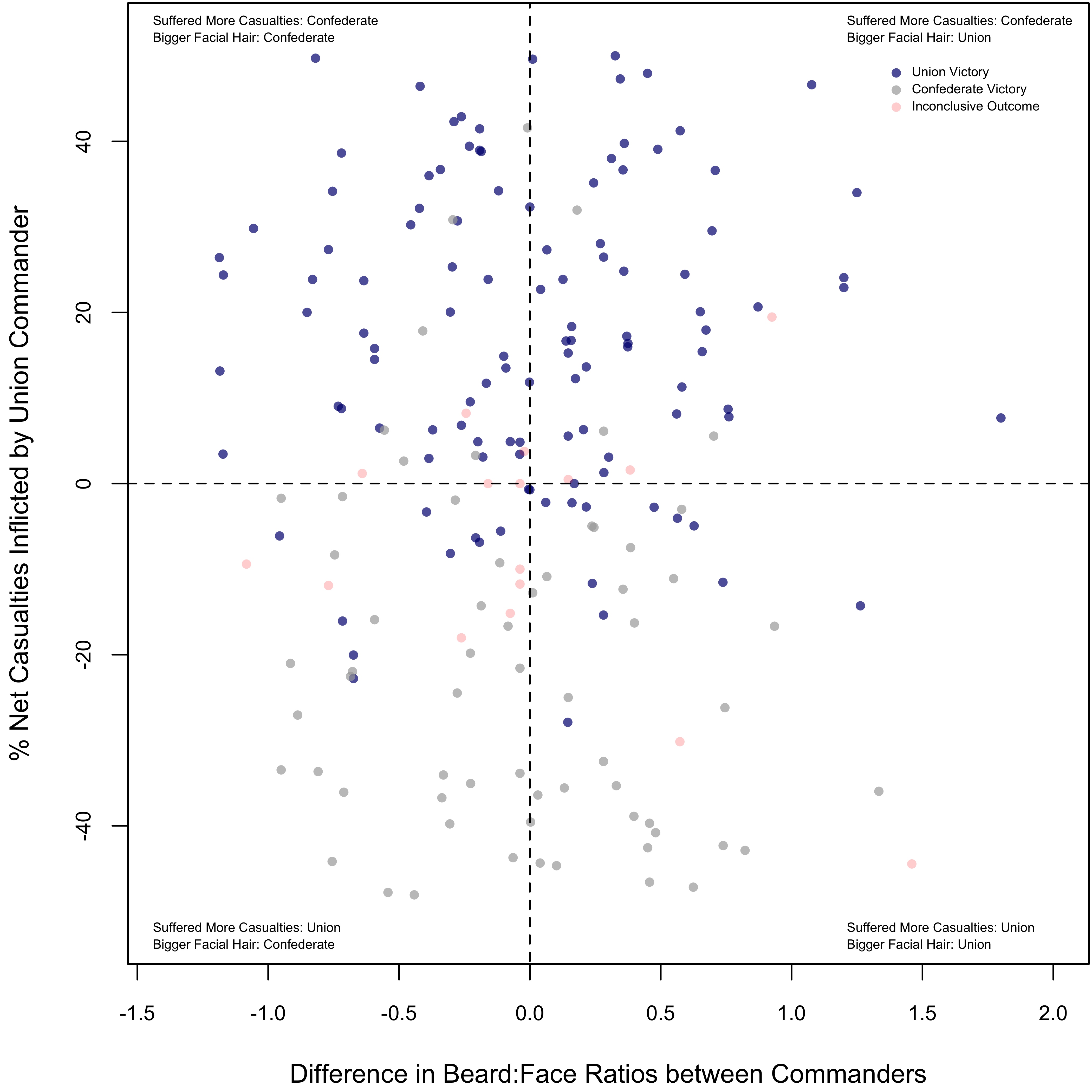
Again, if there was any relationship, the dots would resemble a line, rather than the nonsignificant confetti cloud that best describes Figure 4. For every battle in which the Union commander had a bigger beard and inflicted much more casualties (like the Battle of Franklin), there was a battle like Fort Wagner in which the Union Commander out-bearded his opponent but suffered much more casualties. We again tested for relationships for all data, and grouped by North & South, but found nothing even close to significant. Thus, the size of your beard relative to your opponent’s has very little to do with the number of casualties you suffer in battle.
Conclusions
So does facial hair positively correlate with success on the battlefield? Yes and no, but mostly no. The strongest pro-facial hair data is the fact that Clean Shaven commanders won only 14 of the 37 battles they were involved in (Table 1), the second-worst winning percentage. When you factor in that 2 of those 14 victories came against an opponent that was also Clean Shaven, the probability that a Clean Shaven commander defeated a hairy one was about 32%.
But the size of one’s facial hair did not seem to matter. When two pillose commanders faced each other, the one with more facial hair won only two more battles than the less hairy one. Beard size did not correlate in any way with net casualties inflicted (Fig. 3). Both full beard styles (e.g., short beard and long beard) inflicted far less casualties than muttonchops with moustache and plain muttonchops (Fig. 2). Commanders that destroyed their opponents in facial hair density did not subsequently destroy their opponents on the battlefield (Fig. 4).
With the U.S. official ban on facial hair in the military, and ever-improving razor technology, we may never see an American war with as much barbatuity as the Civil War. In terms of military success, our research demonstrates that this paucity of pilosity may not matter all that much. But in terms of nostalgic, beardy awe, it appears nothing will top the American Civil War.
More Articles Below!

Proceedings of the Natural Institute of Science (PNIS) by https://instsci.org/ is licensed under a Creative Commons Attribution-ShareAlike 4.0 International License.


